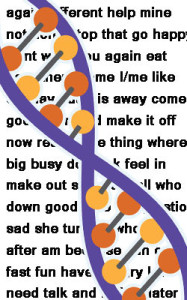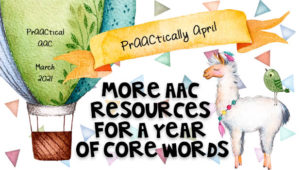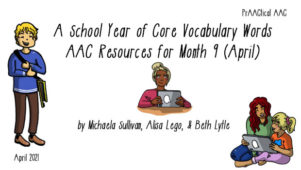More on Teaching Core Vocabulary
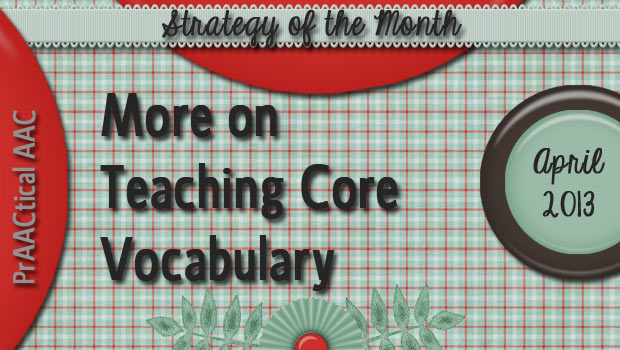
Last week, we talked about two key strategies for teaching core language: using aided language input and creating frequen t opportunities to teach and elicit core words. In today’s post, we’ll expand the number of words and discuss two additional considerations for teaching core words.
t opportunities to teach and elicit core words. In today’s post, we’ll expand the number of words and discuss two additional considerations for teaching core words.
Aided language input is always important in working with beginning users of AAC. It exposes them to their new means of communication, provides them with a competent model of their AAC system, and introduces them to words and symbols they don’t yet know within a meaningful context. It also forces us to slow down when talking, something that can be very beneficial when you consider that many beginning users of AAC also have difficulty processing oral language. (It may take them longer to decode what they’re hearing and they may have to concentrate more than the average kid.) If you’ve actually tried pointing to symbols as you talk, you know what we mean; It’s practically impossible to use your normal speaking rate when providing AAC input. For individuals just starting out on their AAC journeys, that’s a good thing. Our slowed rate of communication gives them more time for processing. Another thing to note about aided language input: It sends a message to the learner that using this AAC tool is important. “Hey, if my SLP, teacher, parent, and aide are all using it, that must mean it’s good stuff.” On the other hand, if it’s not important enough for us to use, why would the kids bother? Our actions speak, and using aided language input is one way to show beginning AAC learners just how much we believe in the tools we have given them.
Creating frequent opportunities for teaching core words is another ‘must.’ How many is enough? Hard to put an exact number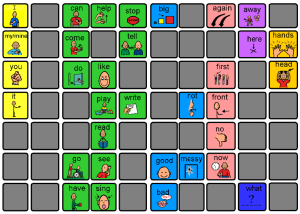 on it since our learners are such a diverse group. But we’re talking about dozens and dozens and dozens over the course of a week. 100+ for some learners. That’s elicitations, not exposures. Beginning learners have to say the words over and over in order to learn them. Just watching us use the SGD or communication board, while important, is insufficient. They have to get in there and get a lot of practice using those words. They need to use them in daily routines, specific teaching activities, group experiences, and in conversation. They need to use them in therapy, and in real life situations at home, in school, and in the community. Of course, they’ll need help in saying these words for the first few weeks. We’ll talk more about that next week, but the main idea is that we don’t wait for them to be independent. We provide support and help them say these words dozens and dozens of times each week.
on it since our learners are such a diverse group. But we’re talking about dozens and dozens and dozens over the course of a week. 100+ for some learners. That’s elicitations, not exposures. Beginning learners have to say the words over and over in order to learn them. Just watching us use the SGD or communication board, while important, is insufficient. They have to get in there and get a lot of practice using those words. They need to use them in daily routines, specific teaching activities, group experiences, and in conversation. They need to use them in therapy, and in real life situations at home, in school, and in the community. Of course, they’ll need help in saying these words for the first few weeks. We’ll talk more about that next week, but the main idea is that we don’t wait for them to be independent. We provide support and help them say these words dozens and dozens of times each week.
Building a Connection Between A Symbol and Its Meaning
Jess is a little boy with autism who is learning to use picture-based communication apps, low tech SGDs, a daily schedule, and many other visual supports. Once he learns that “Symbol X’ means a particular thing, he seems to quickly recognize it across the different communication and learning tools. He isn’t yet independent in using that symbol for communication purposes, but he doesn’t have any difficulty finding it. Some AAC learners seem to look at a symbol for a word they’ve learned and recall it without much effort. Others, however, benefit from explicit instruction focusing on why a particular symbol means a certain thing. We talked about activities designed to teach the meaning of the symbols in a post earlier this week. In addition to those, you can do a number of fun practice activities to build fluency and speed retrieval of core words/symbols. Simple games (which we prefer to ‘tasks’) that have been adapted to provide practice on core words can work well for some learners. Special versions of games like Lotto, Bingo, Twister, and Guess Who can give us opportunities to provide practice recognizing and retrieving core words and build game-playing skills at the same time. We can adapt bean bags and beach balls with core words and have fun saying them as we catch or toss. As we do, we can talk about the symbolization and strengthen their understanding.
Strengthening the Retrieval Process
Another thing that we can do to help people learn and use core words is to have those words be located in a consistent 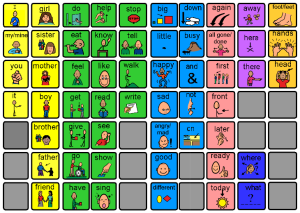 location on the various communication tools. Take our computer keyboards, for example. Whether I’m on my personal laptop, desktop, iPad, office computer, or even smartphone, I know exactly where to look for the letters C-A-R-O-L-E. If the letters were in different places on each keyboard, two things would probably happen: typing speed would decline and the number of errors would increase.
location on the various communication tools. Take our computer keyboards, for example. Whether I’m on my personal laptop, desktop, iPad, office computer, or even smartphone, I know exactly where to look for the letters C-A-R-O-L-E. If the letters were in different places on each keyboard, two things would probably happen: typing speed would decline and the number of errors would increase.
It makes sense that when things stay in the same place, it’s easier to find them when you need them. The problem is that when we begin selecting or creating communication displays for beginning AAC learners, we often start with a small set of words organized in a particular way (e.g., modified Fitzgerald Key). When it comes time to add more words, we either have to move those words around or violate the organizational schema we started. Either way, it’s not good for learning. If we move things around to accommodate the new words, kids have to unlearn what we just taught them. What used to be on the bottom left may be be dead center, for example. Or the new verbs that we added are in with the prepositions because there wasn’t anymore room in the verb columns. Sure, they can find them if they look long enough, but it’s just not an efficient approach to learning. How would YOU like to have to adjust to having letters in different places every time you sat down at a different keyboard? If it would be challenging for us, then it’s not something we’d want to inflict on our AAC learners.
What’s the alternative? To start with the end in mind. In the communication boards shown here, from the TELL ME Curriculum that I did with Lori Wise, we started with a full version of the communication board, knowing that was where we wanted to ‘end up’ a few months down the line. From there we backtracked, masking some of the words/symbols to make two simpler versions. That allowed the teacher to begin with the starter version (the one with the fewest words/symbols) and add the next set of words/symbols into their rightful places a little at a time. This accommodated the children’s need to start with a relatively simple board, and maximized learning efficiency by expanding the board in a way that made sense.
What Can You Say with 2 Dozen Words?
In last week’s post, we selected 12 core words that might be a good starting point for some learners. Today, we’re adding 12 more just to give an example of how we might move forward in our semantic instruction. These are just examples, and there are many more examples out there. We’ve listed some of them later in this post. No matter which 24 core words you choose to teach in the first few weeks, the result is the same: The words that the learner acquires can be used throughout the day in a wide variety of activities and environments. But what kind of linguistic expression is possible at this early stage?
They’ll be able to say 24 single words, including pronouns, verbs, modifiers, determiners, locatives, interrogatives: I, you, it, go, help, play, stop, tell, want, all, big, different, fun, good, sad, more, not, on, away, here, tell, that, this, what; PLUS
- Stop/want/play/tell + it/that/this/all
- Not + big/good/different/fun/sad
- Go + away/here
- More + that/this
- More + help/play; Help/play + more
- What + that/this/play?
- It/That + big/good/different/fun/sad
- I/You/It/That + big/good/here/different/fun/sad; PLUS
3-word sentences, such as
- I/You/It + go/help/stop/want/tell/play+ that/this/here/more
- It/That + not + big/good/different/fun/sad
- Not + go + away/here
- Not + stop/want/play + it/that/this
- I/You/It/That + not + big/good/here/different/fun/sad; PLUS
4-word sentences, such as
- I/You/It + not + go/help/stop/want/tell/play+ that/this/here/more
Next week, we’ll be sharing the communication boards we made to go along with the 12, 24, and 36 words we selected for this series of posts. In the meantime, if you need some examples of how professionals are providing core vocabulary, here are some you may want to check out.
- Kate Ahern’s Core Vocabulary in 3 Symbol Types (and Core Word Learning Book) via SlideShare
- Core language board with 20 PCS and 12 PCS by Yvonne Green via SET-BC
- PCS communication book (core and fringe) from the AT4All Wiki/Barbara Cannon
- PCS communication book pages in Boardmaker and PDF format by Polk County Public Schools FDLRS/ESE
- PCS Tabbed communication book by Deanna Wagner
- PCS tabbed communication book (young children), for elementary school-aged children, and HS students in PDF format by Jefferson Parish Public Schools
- Pixon Boards in various sizes (20, 30, 50, 77, 112) by Gail Van Tatenhove
- Tri-fold PCS book from the AT Team at Orange County Public Schools (Florida)
Teaching core words isn’t quick and it isn’t easy. Core language instruction isn’t simple and it isn’t always intuitive. What it is, though, is powerful. It’s teaching kids to fish for themselves rather than serving them up a plate. It’s laying a foundation so that they will ultimately be able to say what they want at any point in time. It’s worth it.
Filed under: Strategy of the Month
Tagged With: core language, core vocabulary, semantic instruction
This post was written by Carole Zangari
